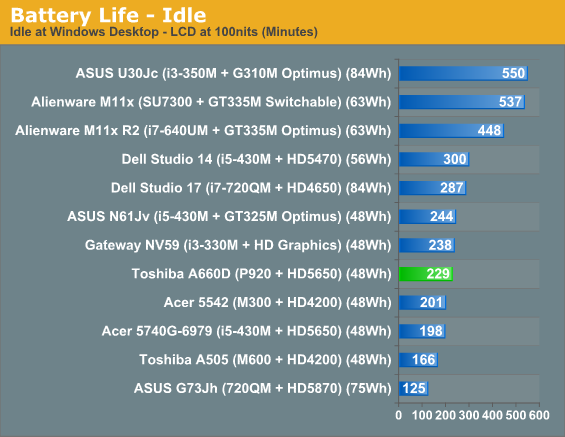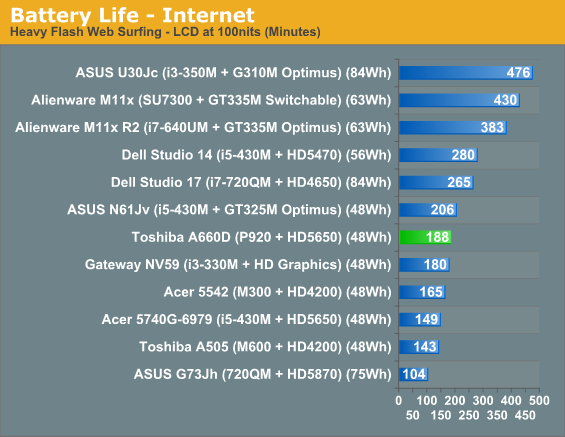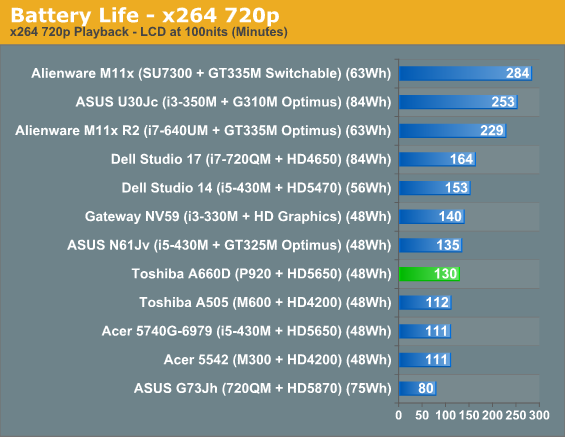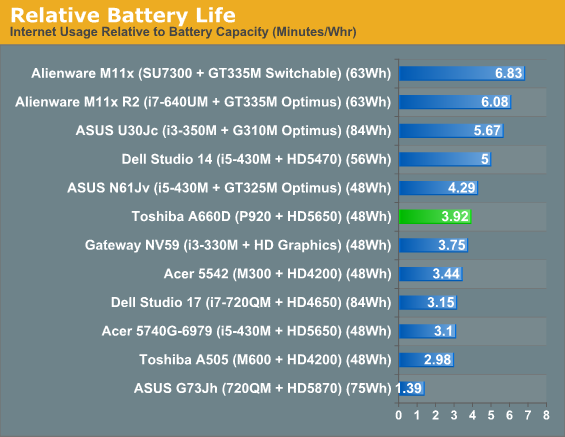Toshiba Satellite A660D-ST2G01: AMD's Quad-Core Phenom II P920 Joins the Mobile Party
by Jarred Walton on August 31, 2010 12:45 AM EST(Somewhat) Improved Battery Life
And now we come to the biggest change with Danube: better battery life. The Toshiba A660D isn't going to set any records, but considering it has a relatively small 48Wh battery and a quad-core processor it does well. We've optimized all of the laptops as much as possible to improve battery life, so keep that in mind—there's no AV or firewall software running, extraneous utilities are disabled, and we're using the Power Saver profile. We're also running off the integrated HD 4250 graphics for the battery results; if you choose to use the 5650, expect to lose at least 10-15% of the battery life. The LCD brightness is calibrated to ~100nits (58% in this case).




The A660D posts idle battery life just shy of four hours and Internet battery life of just over three hours. The x264 score is still pretty bad, lasting just long enough to get through a typical single movie, but again relative performance is important. Overall, battery life is up 16-38% over the Toshiba A505D, and 13-17% better than the Acer 5542 (M300). We're certainly curious as to how the dual-core P520 compares, given it has two fewer cores to power, but the P920 manages to beat the old M300 and M600 so that's already a clear win for the new Champlain parts.
What's not so rosy is the performance and battery life picture when we bring Intel results into the discussion. The quad-core Clarksfield cores deliver poor battery life, but considering i3-330M offers similar overall performance to the P920 in most tests (actually it's better performance overall) that's not really a good comparison. ASUS' N61Jv with Optimus and the Gateway NV59 are close to the A660D in terms of size and battery life. Intel still has a clear lead in overall performance, especially if you start including higher-end parts, but pricing and graphics performance generally favors AMD. At least it's no longer a 25% performance deficit with 25% worse battery life.
For the interested, the A660D consumes an average of around 15.3W during our Internet test, and just 12.6W at idle. The A505D consumes 17.4W idle and 20W in the Internet test, while the ASUS N61Jv uses 14W for Internet surfing and 11.8W at idle. Those results are on battery power using the test settings.










33 Comments
View All Comments
bennyg - Thursday, October 7, 2010 - link
This quad core simply has no logical benefit to it. Who buys a quad core for price and battery life (given Intel's penchant for monopolistic behaviour, if this was a market segment worth worrying about we'd have a dedicated mobile i7 quad die not harvested desktop Lynnfields)Even in benches where it's sposed to benefit from highly multithreaded workloads - e.g. cinebench multi - it's beaten by a i3. Why would AMD even bother releasing something this poor is beyond me.
AMD notebooks like this don't sell because they don't make sense.
The Crying Man - Tuesday, August 31, 2010 - link
Wow... $950 for this? Amazon's selling the dv6-3050us with the Phenom II N930 for $890 and even cheaper on Newegg - better processor, driver support from AMD, and the GPU has normal clocks. Toshiba must put a premium for an ExpressCard slot or their cheap looking designs... What kinds of stupid thoughts go through the minds of that company's decision makers?I think it's time AMD started making their own special edition laptops with configurations OEMs aren't willing to put together. Why can't we get a MR HD5870 + Phenom II X920 BE?
Roland00 - Tuesday, August 31, 2010 - link
That specific model has even been cheaper before. One week on newegg it was 779, and if you did a 50 MIR it was 729 AR. Another week Frys.com had a similar promotion where it was 799 and if you did a 50 MIR it was 749 AR.The Crying Man - Tuesday, August 31, 2010 - link
Yep, bought mine way back in July on Amazon when it was $775.blackshard - Tuesday, August 31, 2010 - link
Hello. Just a suggestion: check the battery wear level on this notebook (hwmonitor does it well). I just bought an Toshiba L650-10H with an AMD P520 (2.3 Ghz part) and HD5650. The video chip was clocked to 450 Mhz, as far as I remember. Anyway the 48Wh battery came with a silly 20% wear level, leaving around 39Wh for a brand new laptop. I don't know if it is a faulty battery or a "feature" coming straight from the factory, but it is enough for me to drop away toshiba notebooks.Also the display was the worst thing I've ever seen: the Windows 7 loading logo is exposing a really huge dithering problem with colors fading to black.
JarredWalton - Thursday, September 2, 2010 - link
HWMonitor reports the wear level as 2%, which probably came from me going through 10-12 recharge cycles during testing. Now, I wish I could say as much for another laptop I just got, where the wear level is reporting at 30%. :-\larson0699 - Tuesday, August 31, 2010 - link
I'm on an A665 at work, P920, 4GB, 500GB, 16", $799. We've had this for a while now. But whenever I'm in early or need to get online during break, this is the machine I use. Absolutely brilliant on Toshiba's part. It's a shame we don't also sell Sony...hgd - Tuesday, August 31, 2010 - link
<quote>On the other hand, AMD specs the P920 for 25W compared to 35W on the 720QM,
</quote>
Doesn't 720QM have 45W TDP?
JarredWalton - Tuesday, August 31, 2010 - link
Correct. Fixed.Cal123 - Tuesday, August 31, 2010 - link
Acer has a P520 with 5650 in a 15.6" for only $599, I'd really like to see a review of that. It looks good to me, if Acer put it together well. I don't think Acer screws up the graphics like Toshiba does.Aspire 5551G-4591
http://www.microcenter.com/single_product_results....